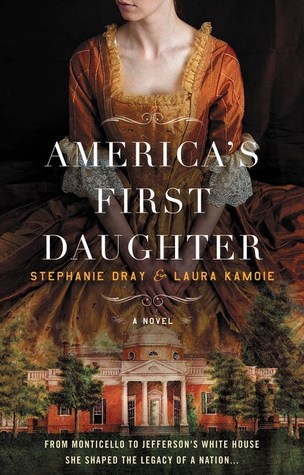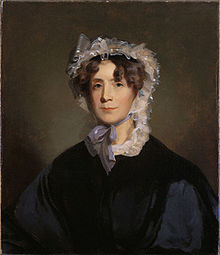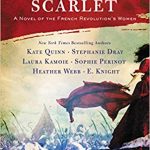 America's First Daughter by Stephanie Dray, Laura Kamoie
America's First Daughter by Stephanie Dray, Laura Kamoie Formats available: paperback, ebook, audiobook
Pages: 624
Published by William Morrow Paperbacks on March 1st 2016
Purchasing Info: Author's Website, Publisher's Website, Amazon, Barnes & Noble, Kobo, Bookshop.org
Goodreads
In a compelling, richly researched novel that draws from thousands of letters and original sources, bestselling authors Stephanie Dray and Laura Kamoie tell the fascinating, untold story of Thomas Jefferson’s eldest daughter, Martha “Patsy” Jefferson Randolph—a woman who kept the secrets of our most enigmatic founding father and shaped an American legacy.
From her earliest days, Patsy Jefferson knows that though her father loves his family dearly, his devotion to his country runs deeper still. As Thomas Jefferson’s oldest daughter, she becomes his helpmate, protector, and constant companion in the wake of her mother’s death, traveling with him when he becomes American minister to France.
It is in Paris, at the glittering court and among the first tumultuous days of revolution, that fifteen-year-old Patsy learns about her father’s troubling liaison with Sally Hemings, a slave girl her own age. Meanwhile, Patsy has fallen in love—with her father’s protégé William Short, a staunch abolitionist and ambitious diplomat. Torn between love, principles, and the bonds of family, Patsy questions whether she can choose a life as William’s wife and still be a devoted daughter.
Her choice will follow her in the years to come, to Virginia farmland, Monticello, and even the White House. And as scandal, tragedy, and poverty threaten her family, Patsy must decide how much she will sacrifice to protect her father's reputation, in the process defining not just his political legacy, but that of the nation he founded.
My Review:
Before I started reading America’s First Daughter, I looked at the page count and wondered what on Earth I was thinking when I agreed to this tour. Then I started the book and the pages just melted away.
As a story, it also goes surprisingly well with my earlier book this week, The Sisters of Versailles. Not that their stories have much in common, but there’s that thread of “fiction has to make sense, history just has to be true” that applies to both of them.
Patsy Jefferson’s life was extraordinary in so many ways. And just as with the Mailly-Nesle sisters in Versailles, the more amazing that a part of her story is, the more likely it is to be true. And because of that, the parts that are backed up by the documentary record ring with sincerity, where the parts on which history is silent or uncertain seem to ring a bit hollow.
I’ll explain that in a minute or two.

But overall, the life of Patsy Jefferson Randolph is an amazing story of someone who was witness to epoch-making events in history, but who still suffered the many trials and tribulations of an all too real life. She’s known in history for being Thomas Jefferson’s daughter, and she is also the person most responsible for the legend that her father became. She was his most constant helpmate throughout his life, and more importantly, she was the person who edited his voluminous papers for publication after his death.
We know him because of her. And through this marvelous piece of historical fiction, we know her because of him.
The story in America’s First Daughter is told through Patsy’s eyes, from one of her earliest memories to after her father’s death. At the beginning of the story, Patsy is a child. The first time we meet her is during the American Revolution, when in 1781 the family was forced to flee Monticello barely ahead of Benedict Arnold’s invasion. So her life from its very beginning is heavily influenced by her father’s politics and service to the Revolution.
While we follow Patsy’s story, we see her grow up. Her perspective begins as a child’s perspective, and with a child’s understanding. But it is tempered with early adult responsibilities – her mother, on her deathbed, makes Patsy promise to take care of her father. It’s a promise that fixes the course of Patsy’s entire life.
In the story, at least, Patsy is the person who keeps her father enough in the world that he resists the siren song of depression after his wife’s death. As Patsy grows up, she gives up the love of her life in order to remain with her father, and then marries badly because of the prospects for remaining near her father and repairing the family fortune. Only half of that hope comes true.
While it seems as if Patsy’s life might be typical of the period, as she sacrifices her own desires to remain close to her father, that closeness also brings her into places and positions that she might not have otherwise seen.
Patsy, whose childhood is marked by the American Revolution, goes to Paris with her father when he becomes the U.S. Minister to France in 1784. In Paris, Patsy witnesses her second revolution, the hopeful beginning of the French Revolution. She sits at her father’s side as he entertains the fathers of that Revolution, including Lafayette. Fortunately for her, she is back in America when it all goes “smash”.
As an adult, Patsy serves as her father’s First Lady in the White House, as Jefferson never remarried. She is part of the Washington City political whirl at the highest level, and having influence as great as Dolley Madison, another activist First Lady.
And through it all, she deals with her own feelings about her father’s shadow family. In France, she is drawn to the abolitionist cause, while at the same time being all too aware that her father is carrying on an affair with a young girl her own age that he owns, and who is the half sister of the wife he loved. Patsy’s feelings about that relationship, the family it creates, and the whole pernicious institution of slavery, shadow her throughout her life.
Because this is Patsy’s story, we see Jefferson from the perspective of a woman who worshipped her father, but at the same time saw the man as he really was – human like the rest of us, with feet of clay up to his knees.
Escape Rating A-: I read most of this in one night. Once I got into it, the pages absolutely fly by.
It does take a bit of getting into. Because we are seeing this story from Patsy’s point of view starting in her childhood, her perspective on people and events while she is a child seems a bit naive and short-sighted. Things make sense from that perspective, but the story becomes much more interesting when the view is through her adult eyes and adult understanding.
Because her father’s relationship with Sally Hemings begins when both girls are around 14 or 15, we also see that relationship initially through Patsy’s limited understanding, and then feel her grow up as she examines her feelings about what that relationship means. She is, as any young woman in her situation would be, jealous of anyone taking a piece of her father’s attention. He is still everything to her. At the same time, the French abhor slavery, and Patsy absorbs that attitude. She can’t help but wonder about Sally’s position in that relationship. Her father has all the power. He owns Sally. Do Sally’s feelings come into anything? Is she coerced by the power imbalance? Or is she just trying to make the best of a situation she has absolutely zero control over? Patsy never knows, because the existence of such shadow families is never discussed. The gap is one that Patsy can’t make herself bridge, and Sally cannot cross.
We also see Jefferson the man in a different light in regards to his daughter. She loves him and wants to please him. While he does everything in his considerable power to make sure that she is, if necessary, guilted to remain at his side, against her own best interests. As a father, Jefferson makes a better politician. He doesn’t want to give up anyone he controls, and will manipulate those people to achieve his ends.
One of the parts of the book that doesn’t quite ring true is Patsy’s relationship with her father’s protege, William Short. Short did exist, but there doesn’t seem to be any documentary evidence that he and Patsy had a relationship other than friends or acquaintances. The early parts of their relationship in the book felt a bit like the authors wanted to insert a romance, both to give Patsy some happiness in her life and to provide a way to illustrate Jefferson’s possessiveness.
Patsy has a difficult life in so many ways, and they are all pretty much documented. While the hardships she faced are alleviated by her service to and with her famous father, that she put him first also seems to have exacerbated many of the troubles she faced. The reader certainly feels the “catch-22” she is caught in.
Patsy finds herself caught, over and over, between opposing forces. She is stuck in the middle between her father and her husband. She is caught between her desire to abolish slavery and the reality that the economy of owning other people is the only thing keeping her family financially afloat for as long as it does. Sally is her aunt, Sally’s children are both her sisters and brothers and her cousins, and she can’t treat them as family or even discuss the situation with anyone. Her husband beats her and their children, and she herself is his property to abuse as he pleases.
To the end of her own life, she is the stalwart protector of her father and his legacy. She saw so much that we will never know, not because the papers didn’t exist, but because she pruned those papers to make sure that his legacy remained untarnished. The life that made her the person who structured his history is fascinating.






















Glad to hear you liked this one! I’m slightly worried about the page count. 624, yikes. Else I might check it out, but I don’t have time to read a book that length at the moment.
I love historical fiction, need to check this one out! Great review xx
Wow, what a fascinating story! It would be really interesting to be able to sit with her and have dinner one night!
Thank you for sharing your thoughts as part of the tour!